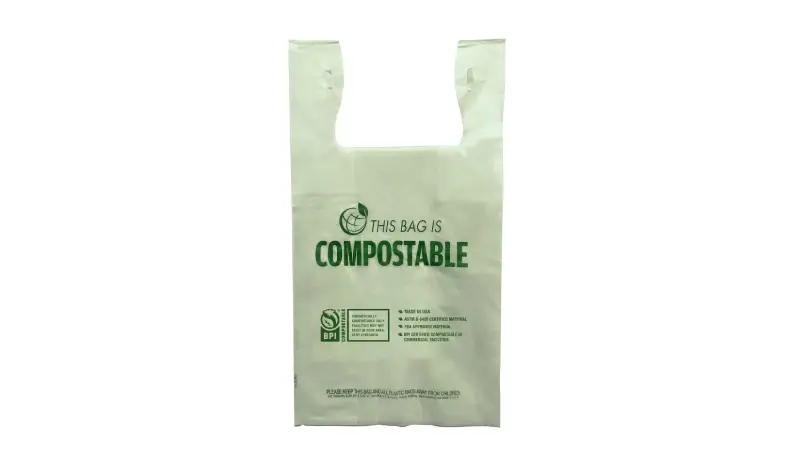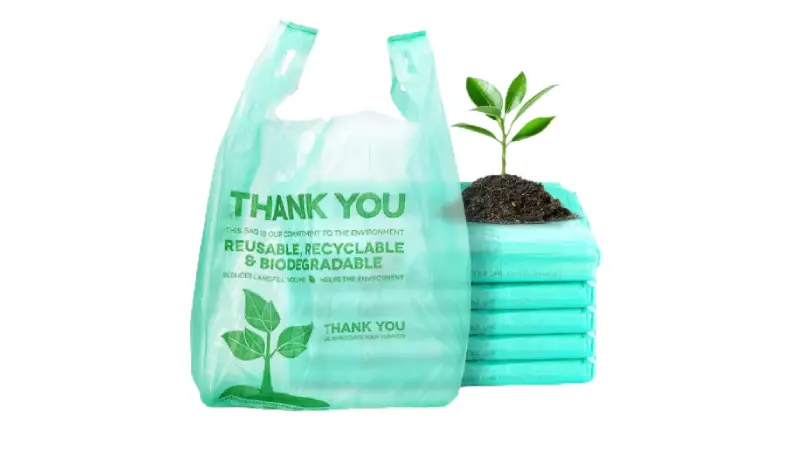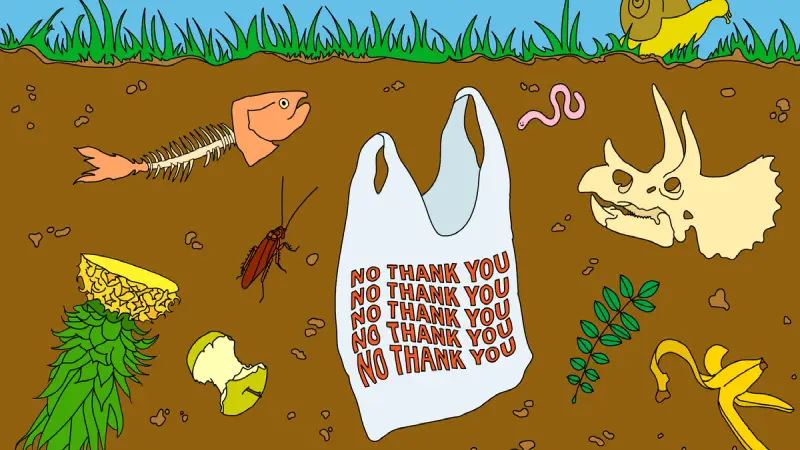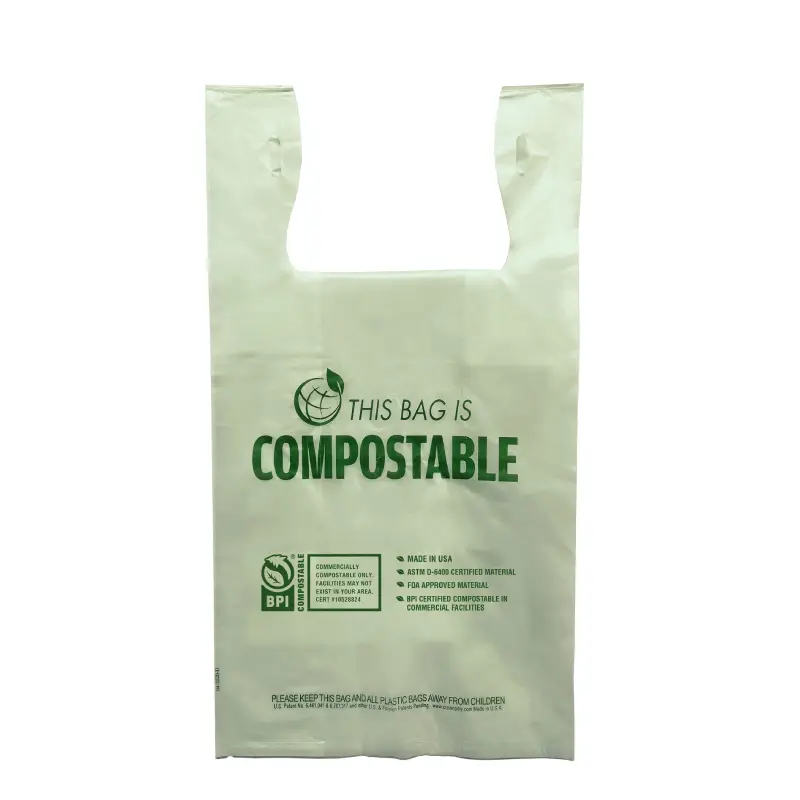The global plastic pollution crisis is worsening, with traditional plastics causing severe environmental damage. Landfills and oceans are overflowing with non-degradable plastics, harming wildlife and ecosystems.
To combat this crisis, we must seek viable alternatives.
One such solution is compostable bags. Unlike conventional plastic, these bags break down into natural elements under specific conditions, reducing pollution and promoting sustainability.
Today, we will explore what are compostable bags, their importance, and how they compare to biodegradable plastic bags.
If you have any questions about this article, feel free to contact us.
What Are Compostable Bags?

What Is a Compostable Bag?
A compostable bag is a type of bag designed to break down completely into non-toxic components, such as carbon dioxide, water, and biomass, under industrial or home composting conditions. These bags do not leave harmful residues and contribute to nutrient-rich compost.
Materials Composition of Compostable Bag
Compostable bags are typically made from natural plant-based polymers, such as:
- PLA (Polylactic Acid) – Derived from corn starch or sugarcane, PLA is biodegradable under composting conditions.
- PHA (Polyhydroxyalkanoates) – A biopolymer produced by bacteria that naturally decomposes in the environment.
- PBAT (Polybutylene Adipate Terephthalate) – A biodegradable polymer often blended with other bioplastics to improve flexibility.
Decomposition Mechanism of Compostable Bags:
Compostable bags are engineered to break down through a natural biological process, primarily facilitated by microorganisms. This process occurs under specific conditions, typically found in industrial or well-managed home composting environments. Here’s a breakdown:
- Microbial Action:
- The process begins with microorganisms, such as bacteria and fungi, that are naturally present in compost environments. These microorganisms recognize the bio-based polymers of the compostable bag as a food source.
- They secrete enzymes that break down the long polymer chains of the bag’s material into smaller, simpler molecules.
- Environmental Conditions:
- Temperature: Elevated temperatures, often between 50°C and 70°C in industrial composting, accelerate microbial activity. This heat promotes the rapid breakdown of the bag’s materials.
- Humidity: Adequate moisture is essential. Microorganisms require water to function, so a moist environment is crucial for their activity.
- Oxygen: Most composting processes are aerobic, meaning they require oxygen. Microorganisms use oxygen to break down the organic material, producing carbon dioxide as a byproduct.
- Transformation:
- As the microorganisms consume the bag’s materials, they convert the carbon from the polymers into carbon dioxide.
- The remaining components are transformed into water and biomass, which is a nutrient-rich organic matter that can enrich soil.
- Essentially, the compostable bags are turned into useful compost.
- Complete Breakdown:
- Unlike traditional plastics, which fragment into microplastics, compostable bags are designed to completely decompose, leaving no harmful residues.
- The end result is a valuable compost product that can be used to improve soil health.
This process ensures that compostable bags contribute to a circular economy, where waste is transformed into a valuable resource, rather than accumulating in landfills or polluting the environment.
Why Are Compostable Bags Important?
Environmental Protection
Using compostable bags helps reduce white pollution by replacing single-use plastics. Since they decompose naturally, they do not contribute to the long-term waste problem.
Reduction of Carbon Footprint
Compared to traditional plastics, compostable bags require less fossil fuel-based production. Their raw materials, such as corn or sugarcane, absorb carbon dioxide during growth, offsetting emissions.
Support for the Circular Economy
Compostable bags align with a circular economy by returning organic matter to the soil as compost, reducing landfill waste, and promoting sustainable agriculture.
Compostable Bags vs. Biodegradable Plastic Bags

Definition Comparison
- Compostable Bags: Fully decompose into organic matter within specific composting conditions.
- Biodegradable Bags: Break down over time, but may leave microplastic residues depending on the environment.
Performance Comparison
| Feature | Compostable Bags | Biodegradable Bags |
|---|---|---|
| Breakdown Time | 3-6 months in compost conditions | Several months to years |
| Residue | None, turns into biomass | Possible microplastics |
| Compost Compatibility | Yes | Sometimes |
Application Comparison
- Compostable Bags: Ideal for food waste collection, shopping bags, and agricultural use.
- Biodegradable Bags: Suitable for environments where composting is not available.
Working Principles and Applications of Compostable Bags
Compostable plastic bags are designed to break down in specific environments through the action of microorganisms. This process transforms the bags into carbon dioxide, water, and biomass, effectively returning them to the natural cycle.
Working Principles of Compostable Bags:
- Industrial Composting:
- In industrial composting facilities, conditions are optimized to accelerate decomposition. This involves:
- Controlled Environment: Facilities maintain high temperatures (50-70°C), high humidity, and ample oxygen.
- Microbial Activity: These conditions foster a rich microbial environment, where bacteria and fungi rapidly break down the bag’s polymer chains.
- Transformation: The polymers are converted into carbon dioxide, water, and nutrient-rich compost.
- Industrial composting is very efficient and makes for fast decomposition.
- In industrial composting facilities, conditions are optimized to accelerate decomposition. This involves:
- Home Composting:
- Home composting is a slower process, but still effective:
- Natural Decomposition: Bags are placed in compost piles or bins, where naturally occurring microorganisms initiate breakdown.
- Environmental Factors: Decomposition relies on ambient temperatures and moisture, which vary with the climate and composting method.
- Slower Rate: Due to less controlled conditions, home composting takes longer than industrial composting.
- Maintaining the proper ratio of green and brown materials is extremely important for home composting.
- Home composting is a slower process, but still effective:
Factors Influencing Decomposition of Compostable Bags:
- Temperature:
- Higher temperatures accelerate microbial activity, speeding up decomposition.
- In industrial composting, controlled high temperatures ensure rapid breakdown.
- In home composting, warmer climates and well-insulated piles promote faster decomposition.
- Humidity:
- Moisture is essential for microbial growth and activity.
- Insufficient moisture slows down decomposition, while excessive moisture can lead to anaerobic conditions.
- Oxygen:
- Aerobic composting requires ample oxygen.
- Turning compost piles or providing aeration ensures a sufficient oxygen supply.
- Lack of oxygen can cause the production of methane, which is not desired.
- Microbial Activity:
- A diverse and thriving microbial community is crucial for efficient decomposition.
- Adding compost activators or ensuring a balanced mix of organic materials can enhance microbial activity.
Application Areas of Compostable Bags:
- Retail:
- Compostable shopping bags offer an eco-friendly alternative to traditional plastic bags.
- Produce bags made from compostable materials reduce plastic waste in grocery stores.
- Agriculture:
- Compostable mulch films break down in the soil, eliminating the need for removal.
- Planting pots made from compostable materials decompose, enriching the soil.
- Daily Life:
- Compostable garbage bags facilitate the collection of organic waste for composting.
- Pet waste bags made from compostable materials provide a sustainable solution for pet owners.
- Food Service:
- Food containers are able to be made from compostable materials, making for a much better environmental impact.
- Many restaurants are now using compostable utensils.
By understanding the working principles and diverse applications of compostable plastic bags, we can promote their use and contribute to a more sustainable future.
Advantages and Challenges of Compostable Bags

Advantages of Compostable Bags:
- Reduces Plastic Pollution:
- Compostable bags significantly mitigate the accumulation of persistent plastic waste in landfills and natural environments. They break down into harmless organic matter, reducing the risk of microplastic contamination and harm to wildlife.
- Supports Waste Management Systems:
- These bags facilitate the diversion of organic waste from landfills, which can significantly reduce methane emissions. They integrate seamlessly into composting programs, enhancing the efficiency of waste processing.
- Decreases Dependency on Fossil Fuels:
- Compostable bags are typically made from renewable resources, such as corn starch or sugarcane, reducing reliance on petroleum-based plastics. This helps to conserve fossil fuels and lower the carbon footprint associated with plastic production.
Challenges of Compostable Bags:
- Higher Cost Compared to Conventional Plastic:
- The production of compostable bags often involves more expensive raw materials and manufacturing processes, which can result in higher prices for consumers. This cost barrier can hinder widespread adoption.
- Limited Availability of Industrial Composting Facilities:
- Many regions lack adequate infrastructure for industrial composting, which is essential for the optimal decomposition of these bags. Without access to such facilities, compostable bags may end up in landfills, where they may not decompose properly.
- Lower Durability Than Traditional Plastic Bags:
- Some compostable bags may have lower tensile strength and puncture resistance compared to traditional plastic bags. This can limit their suitability for certain applications, particularly those requiring heavy-duty performance. Also, the shelf life of compostable bags is a concern, as they can start to degrade over time.
Conclusion
Compostable bags offer a sustainable alternative to traditional plastics, reducing pollution and supporting environmental health. Despite challenges, their adoption is essential for a greener future.
We must continue investing in research and promoting compostable solutions to combat plastic waste effectively.
If you’re interested in our products, visit our homepage or contact us for our product catalog.
FAQs About What Are Compostable Bags
What is considered a compostable bag?
A compostable bag is a type of bag that is designed to decompose in specific composting conditions. This means that it will break down into natural elements like carbon dioxide, water, and biomass, leaving no toxic residues behind.
To be considered truly compostable, a bag must meet certain standards, such as those set by organizations like ASTM D6400 or EN 13432. These standards ensure that the bag will decompose at a rate comparable to other compostable materials and that the resulting compost is safe for use in agriculture.
It is very important to know that a compostable bag is much different than a biodegradable bag. Many bags are labeled biodegradable, which only means that over a long period of time the bag will break down into smaller pieces of plastic, leaving behind micro plastics.
Do you really need compostable bags for your food scraps?
Yes, using compostable bags for food scraps offers several benefits. Firstly, it keeps your kitchen cleaner and reduces odors, as the bags prevent food waste from sticking to your bin.
Secondly, it simplifies the composting process, especially in municipal composting programs, as the entire bag can be processed along with the food waste.
Lastly, it diverts plastic waste from landfills, contributing to a more sustainable waste management system. Using compostable bags for food scraps is a very easy way to help the environment.
What do you do with compostable bags?
Compostable bags are designed to be disposed of in composting facilities or home compost systems. In industrial composting facilities, they break down quickly due to controlled conditions.
In home compost systems, they decompose more slowly but still contribute to nutrient-rich compost. It’s important to check your local waste management guidelines, as some areas have specific instructions for compostable bag disposal.
Can you compost tea bags?
Yes, most tea bags are compostable, but it’s essential to check the material. Traditional tea bags are made from paper, which decomposes easily.
However, some newer tea bags contain plastic fibers, which are not compostable. If you’re unsure, it’s best to tear open the tea bag and compost the tea leaves only.
Can you compost paper bags?
Yes, plain brown paper bags are excellent for composting. They break down quickly and add carbon to your compost pile.
However, avoid composting glossy or coated paper bags, as they may contain chemicals that are harmful to your compost.
Can you put compostable bags in green bin california?
It depends on your local municipality in California. Some cities and counties allow compostable bags in green bins, while others do not. Always check your local waste management guidelines to ensure proper disposal.
Where to buy compostable bags?
Contact us for custom orders. We are BN Pack, and we offer a full range of compostable bags. We are professional compostable bag manufacturers china. We provide compost bags wholesale, wholesale compostable bags, and we are compostable bag manufacturers.
We offer compostable bag factory direct wholesale, and have compostable bag wholesale price. We have compost bagging machines, produce compostable produce bags wholesale, and produce compostable carry bags manufacturers.
